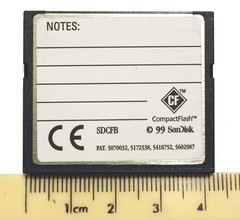Difference between revisions of "CompactFlash"
m (half length of pc cards) |
(Heading added) |
||
| Line 26: | Line 26: | ||
CF is long-lived compared to other flash formats, and new, faster and larger-capacity cards are still in development (in 2011); cards exist in sizes from 2Mb to 128Gb. | CF is long-lived compared to other flash formats, and new, faster and larger-capacity cards are still in development (in 2011); cards exist in sizes from 2Mb to 128Gb. | ||
| + | ==Links== | ||
* [http://en.wikipedia.org/wiki/Compactflash Wikipedia CompactFlash] | * [http://en.wikipedia.org/wiki/Compactflash Wikipedia CompactFlash] | ||
[[Category: Digital]] | [[Category: Digital]] | ||
[[Category:Storage Media]] | [[Category:Storage Media]] | ||
Revision as of 06:14, 29 August 2013
This article is a stub. You can help Camera-wiki.org by expanding it.
|
|
CompactFlash (CF) is a type of flash memory, commonly used for storage in early digital cameras and other digital devices, and still in production (2011). It was originally created by memory manufacturer SanDisk in 1994, with the interface loosely based on the existing PCMCIA slot standard.
Formally, the name "CompactFlash" is written without a space, although "Compact Flash" is also commonly seen. Called compact because it is approx half the length of PC cards (PCMCIA). There are two types - with different thicknesses: type I - 43×36×3.3mm, and type II - 43×36×5mm.
CF is long-lived compared to other flash formats, and new, faster and larger-capacity cards are still in development (in 2011); cards exist in sizes from 2Mb to 128Gb.

